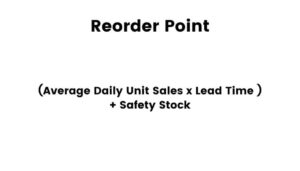Understanding how to calculate an item’s reorder point is essential for any business that doesn’t want to run out of inventory. An item’s reorder point determines a product’s absolute minimum inventory levels, becoming a “trigger point” at which a business reorders more stock.
In this article, we’ll define reorder point, reveal how to calculate reorder point, and help you understand how to use reorder point to make your business more profitable and productive. Finally, we’ll also discuss how inventory management software can help you automate reorder point-related tasks.
What is reorder point?
Reorder point is the specific, predetermined level at which a given product must be replenished to avoid an inventory shortage or stockout. In other words, it’s a minimum inventory threshold that triggers a new order of additional inventory.
Reorder point takes more into account than how much of a particular item your business needs. The calculation also factors how long it takes your suppliers to process orders and how long it takes those suppliers to deliver purchases to your receiving department.
While reorder point can be noted on an inventory spreadsheet or manual inventory list, keep in mind that the reorder point for every item on your shelves will be different. That’s why more and more businesses use inventory management software to set inventory minimums, create low stock alerts, and quickly update details regarding inventory levels and location.
How to calculate reorder point
To calculate reorder point, you’ll need to use the reorder point formula.
Reorder point formula

When determining the reorder point, you’ll also need to solve for two other key calculations, safety stock and lead time. Safety stock is that little bit of extra inventory your business keeps on hand, just in case. And lead time refers to how many days it takes to receive your order once you place it.
Reorder point example
Say you work at a small construction company that stocks drywall anchors. Lately, you’ve been running out of this item and have noticed your employees are having to stop what they’re doing, drive to a hardware store, and pay high retail prices for these anchors. So you decide to calculate your company’s drywall anchor reorder point.
After reviewing your inventory records, you gather all the information you need to calculate reorder point:
- On average, you use or sell about 10 drywall anchors a day.
- Your lead time to receive more drywall anchors is 3 days after an order is placed.
- Your safety stock is 30 drywall anchors.
(10 x 3 ) + 30 = 60
Your reorder point for drywall anchors is 60 units. That means that once your inventory hits 60, it’s time to place another order.
How to use reorder point

There are many ways to use reorder point, from practicing tighter inventory control to getting more from your automated inventory management system. Here are four ways to utilize reorder point:
Optimize inventory control
Inventory control is all about ordering just enough product to satisfy demand without tying up cash carrying inventory you don’t need yet. By properly calculating reorder point, your business can place orders confidently and completely, without overspending on inventory that’ll just sit on the shelves.
Set inventory minimums with precision
Another reason reorder point can improve your company’s inventory control strategy? You won’t feel the need to “pad” orders with extra inventory once you calculate an item’s reorder point. After all, you know you’ve already baked safety stock and lead time into your reorder point.
Customize low stock alerts
With an inventory app like Sortly, you can set customized alerts for each of your item’s reorder points. Then, simply head to a given item’s inventory details, then add the reorder point in the minimum level field.
From there, you can set a customized alert for when inventory hits a certain threshold. You decide who gets notified, when, how often, and whether that notification comes via email, within the Sortly app, or both.
Related: How to set customized low stock alerts for multiple items within Sortly
Update your reorder point calculations often
As you already know, supply and demand can fluctuate—especially during times of uncertainty. That’s why it’s essential your business review the math behind its reorder points regularly.
After all, if you’re suddenly using twice as many pairs of windshield wipers a day, or your mirrored glass supplier now needs twice as long to fulfill your orders, your reorder point has changed. On top of reviewing reorder points from time to time, you can also work on tightening up relationships with suppliers and onboarding backup suppliers should there be an unforeseen interruption to your usual network of providers.
With Sortly, you can adjust your inventory minimums and low stock alerts anytime to keep up with fluctuations.
Related: How to choose great suppliers
About Sortly
Experience the simplest inventory management software.
Are you ready to transform how your business does inventory?
Sortly is a top-rated inventory management app designed to make handling all things inventory—including juggling reorder points—that much simpler. With Sortly, it’s easy to gather the data you need to calculate reorder point, then plug that number right into your inventory details. You can even choose who on your team should be alerted when your inventory is starting to run low.
With Sortly, you can track, manage, and reorder your inventory with confidence and precision. And Sortly’s other powerful automation features can help your team save time and money, too. From in-app barcode and QR code scanning to detail-rich, easy-to-generate reports, Sortly’s sure to make your business more organized and productive.
Ready to give Sortly a try? You can now try Sortly’s premium features completely free with a two-week trial.




